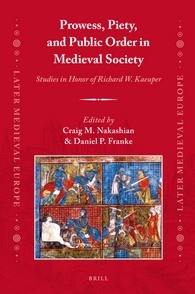Craig M Nakashian and Daniel P Franke (eds.)
Prowess, Piety, and Public Order in Medieval Society: Studies in Honor of Richard W. Kaeuper
(Brill, 2017) 436 pp. $114.00/€99,00
This festschrift celebrating the scholarly and professional career of Richard Kaeuper of the University of Rochester, follows a common pattern. It includes some personal remarks by colleagues and former students, and a number of relevant articles written by them. The book, however, is more than a scholarly celebration (Fest in German) of a respected teacher. It is also an evocation of a teaching environment that must have been as much fun as it was productive – an academic party (also Fest).
Prowess, Piety, and Public Order falls into six parts. Prefatial material on Kaeuper as teacher, mentor, and fellow researcher is succeeded by sections on (1) War and Chivalry (2) Chivalric Identities (3) Religion and Violence (4) Kingship, Public Order, and the State ( 5 ) Literature and Culture in Medieval and Early Modern Europe.
Sections 1, 2, and 3 are of particular interest because each of the articles treats a topic that Kaeuper has been exploring for twenty years: the meaning of chivalry and the significance of violence in medieval society. The authors in these sections are particularly interested in how the chivalric ideals of warriors – whatever they might have been – affected their actual behavior in time of conflict. All of these writers portray pragmatism as more common than any elevated principles of chivalry. These essays describe how violence and limitations thereof affected a variety of social groups, real and fictional, from the French knights of the Song of Roland, whom Bernard Bachrach argues were satirical constructs invented by a hostile, pro-Angevin poet, to feuding monks whom Leah Shopkow sees as using common ideas of belligerent masculinity as weapons to humiliate their rivals in another abbey.
But if violence was a common aspect of High Medieval life, we readers are reminded by a number of articles that warriors did not take their relationship with violence for granted. Articles by Crouch, Sposato, Nakashian and Franke emphasize chivalry as prowess and loyalty, important resources for the greater lords who not only fought as knights but commanded them. The knightly identity was connected to its use by princes to enforce public order.
Chivalric identity was established not only by the teaching of ideals but the depiction of them in literature. The last section of the book consists of several analyses where fictional characters provide guidance or bad examples for audiences that must have been largely aristocratic. Again, the use of such literary portraits of chevaliers and chivalry has been characteristic of Kaeuper’s work. The Festschrift shows other scholars similarly using literary evidence to reconstruct the mental and moral world of knights and their neighbors and relatives.
Kaeuper is hardly the only leading scholar to concern himself with chivalry and its relationship to religion, culture and warfare. Over the years, however, he has inspired many others to share his love for this exciting field. By providing examples of recent work, Prowess, Piety and Public Order conveys some of that excitement. Research libraries that concern themselves with the High Middle Ages will find this a useful addition to their collections.
Steven Muhlberger
Professor of History, Nipissing University (retired)
[email protected]

